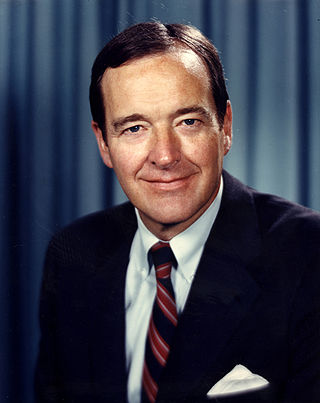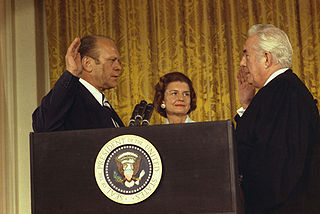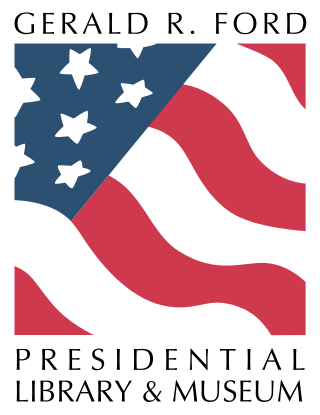
The Watergate scandal was a major political controversy in the United States during the presidency of Richard Nixon from 1972 to 1974, ultimately resulting in Nixon's resignation. It originated from attempts by the Nixon administration to conceal its involvement in the June 17, 1972, break-in at the Democratic National Committee headquarters located in the Watergate Office Building in Washington, D.C.

Gerald Ford's tenure as the 38th president of the United States began on August 9, 1974, upon the resignation of president Richard Nixon, and ended on January 20, 1977. Ford, a Republican from Michigan, had been appointed vice president since December 6, 1973, following the resignation of Spiro Agnew from that office. Ford was the only person to serve as president without being elected to either the presidency or the vice presidency. His presidency ended following his narrow defeat in the 1976 presidential election to Democrat Jimmy Carter, after a period of 895 days in office.

The Richard Nixon Presidential Library and Museum is the presidential library and burial site of Richard Milhous Nixon, the 37th president of the United States (1969–1974), and his wife Pat Nixon.

Frederick Baily Dent was an American businessman who served as the United States Secretary of Commerce from February 2, 1973, to March 26, 1975, during the administrations of U.S. Presidents Richard M. Nixon and Gerald Ford

The Watergate scandal refers to the burglary and illegal wiretapping of the headquarters of the Democratic National Committee, in the Watergate complex by members of President Richard Nixon's re-election campaign, and the subsequent cover-up of the break-in resulting in Nixon's resignation on August 9, 1974, as well as other abuses of power by the Nixon White House that were discovered during the course of the scandal.
"A Head in the Polls" is the third episode in the second season of the American animated television series Futurama, and the 16th episode of the series overall. It originally aired on the Fox network in the United States on December 12, 1999. The episode was written by J. Stewart Burns and directed by Bret Haaland. Claudia Schiffer makes a guest appearance as herself. The title is a pun on the common phrase "Ahead in the polls".

Gerald Rudolph Ford Jr. was an American politician who served as the 38th president of the United States from 1974 to 1977. He previously served as the leader of the Republican Party in the U.S. House of Representatives from 1965 to 1973, and as the 40th vice president under President Richard Nixon from 1973 to 1974. Ford succeeded to the presidency when Nixon resigned in 1974, but was defeated for election to a full term in 1976. Ford is the only person to serve as president without winning an election for president or vice president.
"Halloween Massacre" is the term associated with the major reorganization of United States president Gerald Ford's cabinet on November 4, 1975, which was an attempt to address multiple high-level personality and policy clashes within the administration. The overhaul came at a time when the president's leadership abilities were being broadly questioned, and he was being heavily criticized by California governor Ronald Reagan and others from the nascent conservative wing of the Republican Party.

SAM 27000 was the second of two Boeing VC-137C United States Air Force aircraft that were specifically configured and maintained for the use of the president of the United States. It used the call sign Air Force One when the president was on board, and at other times it used the call sign SAM 27000, with SAM indicating 'Special Air Mission.' The VC-137C serial number 72-7000 was a customized version of the Boeing 707 which entered service during the Nixon administration in 1972. It served all US presidents until George W. Bush and was retired in 2001. It is now on display at the Ronald Reagan Presidential Library.

The inauguration of Gerald Ford as the 38th president of the United States was held on Friday, August 9, 1974, in the East Room of the White House in Washington, D.C., after President Richard Nixon resigned due to the Watergate scandal. The inauguration – the last non-scheduled, extraordinary inauguration to take place in the 20th century – marked the commencement of Gerald Ford's only term as president. Chief Justice Warren E. Burger administered the oath of office. The Bible upon which Ford recited the oath was held by his wife, Betty Ford, open to Proverbs 3:5–6. Ford was the ninth vice president to succeed to the presidency intra-term, and he remains the most recent to do so, as of 2024.

The Gerald R. Ford Presidential Museum is the presidential museum and burial place of Gerald Ford, the 38th president of the United States (1974–1977), and his wife Betty Ford. It is located near the Pew Campus of Grand Valley State University in Grand Rapids, Michigan. Ford's presidential museum is the only such facility under the auspices of the National Archives and Records Administration to be separate from the presidential library, which is located approximately 130 miles (210 km) to the east in Ann Arbor. Despite the separation, the library and museum are a single institution with one director.

The desk in the Vice President's Room of the United States Capitol, colloquially known as the Wilson desk and previously called the McKinley-Barkley desk, is a large mahogany partner's desk used by U.S. Presidents Richard Nixon and Gerald Ford in the Oval Office as their Oval Office desk. One of only six desks used by a President in the Oval Office, it was purchased in 1898 by Garret Augustus Hobart, the 24th Vice President of the United States, for the Vice President's Room in the United States Capitol.
On August 9, 1974, President Richard Nixon was forced to resign amid the Watergate scandal. Vice President Gerald Ford ascended to the presidency, leaving the office of vice president vacant. Under the terms of the 25th Amendment, a vice presidential vacancy is filled when the president nominates a candidate who is confirmed by both houses of Congress, which were controlled by the Democrats.

On October 10, 1973, Vice President Spiro Agnew was forced to resign following a controversy over his personal taxes. Under the terms of the 25th Amendment, a vice presidential vacancy is filled when the president nominates a candidate who is confirmed by both houses of Congress. President Richard Nixon thus had the task of selecting a vice president who could receive the majority support of both houses of Congress, which were then controlled by the Democrats.

Proclamation 4311 was a presidential proclamation issued by President of the United States Gerald Ford on September 8, 1974, granting a full and unconditional pardon to Richard Nixon, his predecessor, for any crimes that he might have committed against the United States as president. In particular, the pardon covered Nixon's actions during the Watergate scandal. In a televised broadcast to the nation, Ford, who had succeeded to the presidency upon Nixon's resignation, explained that he felt the pardon was in the best interests of the country and that the Nixon family's situation was "a tragedy in which we all have played a part. It could go on and on and on, or someone must write the end to it. I have concluded that only I can do that, and if I can, I must."
Jimmy Carter, a Democrat from Georgia, was elected President of the United States on November 2, 1976 and was inaugurated as the nation's 39th president on January 20, 1977, and his presidency ended on January 20, 1981, with the inauguration of Ronald Reagan. The following articles cover the timeline of the Carter's presidency:
The presidency of Richard Nixon began on January 20, 1969, when Richard Nixon was inaugurated as the 37th president of the United States, and ended on August 9, 1974, when, in the face of almost certain impeachment and removal from office, he resigned the presidency.
During the administration of American President Gerald Ford (1974–1977), the president moderated the strict anti-cannabis stance of his predecessor, resigned president Richard Nixon, though this did not result in any significant weakening of federal cannabis policy. In contrast with Nixon's harsh policies, Ford advocated instead reducing the harms associated with drug use. Ford struck a more conciliatory tone, identifying drug users as victims of traffickers, rather than criminals.
The following is a timeline of the presidency of Gerald Ford from August 9, 1974, when Ford became the 38th president of the United States, upon the resignation of Richard Nixon, to December 31, 1974.













